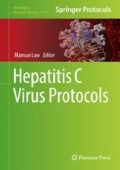Abstract
Hepatitis C virus (HCV) pseudoparticles (HCVpp) are generated by cotransfection of HCV envelope (E1 and E2) genes along with a retroviral packaging/reporter construct into HEK293T cells. Enveloped particles bearing HCV E1E2 proteins on their surface are released through a retroviral budding process into the supernatant. Viral E1E2 glycoproteins facilitate a single round of receptor-mediated entry of HCVpp into hepatoma cells, which can be quantified by reporter gene expression. These HCVpp have been employed to study mechanisms of HCV entry into hepatoma cells, as well as HCV neutralization by immune sera or HCV-specific monoclonal antibodies.
Access this chapter
Tax calculation will be finalised at checkout
Purchases are for personal use only
References
Bartosch B, Dubuisson J, Cosset FL (2003) Infectious hepatitis C virus pseudo-particles containing functional E1- E2 envelope protein complexes. J Exp Med 197:633–642
Hsu M, Zhang J, Flint M, Logvinoff C, Cheng-Mayer C, Rice CM et al (2003) Hepatitis C virus glycoproteins mediate pH-dependent cell entry of pseudotyped retroviral particles. Proc Natl Acad Sci U S A 100:7271–7276
Bartosch B, Vitelli A, Granier C, Goujon C, Dubuisson J, Pascale S et al (2003) Cell entry of hepatitis C virus requires a set of co-receptors that include the CD81 tetraspanin and the SR-B1 scavenger receptor. J Biol Chem 278:41624–41630
Cormier EG, Tsamis F, Kajumo F, Durso RJ, Gardner JP, Dragic T (2004) CD81 is an entry coreceptor for hepatitis C virus. Proc Natl Acad Sci U S A 101:7270–7274
McKeating JA, Zhang LQ, Logvinoff C, Flint M, Zhang J, Yu J et al (2004) Diverse hepatitis C virus glycoproteins mediate viral infection in a CD81-dependent manner. J Virol 78:8496–8505
Zhang J, Randall G, Higginbottom A, Monk P, Rice CM, McKeating JA (2004) CD81 is required for hepatitis C virus glycoprotein-mediated viral infection. J Virol 78:1448–1455
Giang E, Dorner M, Prentoe JC, Dreux M, Evans MJ, Bukh J et al (2012) Human broadly neutralizing antibodies to the envelope glycoprotein complex of hepatitis C virus. Proc Natl Acad Sci U S A 109:6205–6210
Law M, Maruyama T, Lewis J, Giang E, Tarr AW, Stamataki Z et al (2008) Broadly neutralizing antibodies protect against hepatitis C virus quasispecies challenge. Nat Med 14:25–27
Morin TJ, Broering TJ, Leav BA, Blair BM, Rowley KJ, Boucher EN et al (2012) Human monoclonal antibody HCV1 effectively prevents and treats HCV infection in chimpanzees. PLoS Pathog 8:e1002895
Osburn WO, Snider AE, Wells BL, Latanich R, Bailey JR, Thomas DL et al (2014) Clearance of hepatitis C infection is associated with the early appearance of broad neutralizing antibody responses. Hepatology 59:2140–2151
Pestka JM, Zeisel MB, Blaser E, Schurmann P, Bartosch B, Cosset FL et al (2007) Rapid induction of virus-neutralizing antibodies and viral clearance in a single-source outbreak of hepatitis C. Proc Natl Acad Sci U S A 104:6025–6030
Keck ZY, Xia J, Wang Y, Wang W, Krey T, Prentoe J et al (2012) Human monoclonal antibodies to a novel cluster of conformational epitopes on HCV e2 with resistance to neutralization escape in a genotype 2a isolate. PLoS Pathog 8:e1002653
Bailey JR, Wasilewski LN, Snider AE, El-Diwany R, Osburn WO, Keck Z et al (2015) Naturally selected hepatitis C virus polymorphisms confer broad neutralizing antibody resistance. J Clin Invest 125:437–447
Dowd KA, Netski DM, Wang XH, Cox AL, Ray SC (2009) Selection pressure from neutralizing antibodies drives sequence evolution during acute infection with hepatitis C virus. Gastroenterology 136:2377–2386
Urbanowicz RA, McClure CP, Brown RJ, Tsoleridis T, Persson MA, Krey T et al (2016) A diverse panel of hepatitis C virus glycoproteins for use in vaccine research reveals extremes of monoclonal antibody neutralization resistance. J Virol 90:3288–3301
Swann RE, Cowton VM, Robinson MW, Cole SJ, Barclay ST, Mills PR et al (2016) Broad anti-hepatitis C virus (HCV) antibody responses are associated with improved clinical disease parameters in chronic HCV infection. J Virol 90:4530–4543
Wasilewski L, Ray S, Bailey JR (2016) Hepatitis C virus resistance to broadly neutralizing antibodies measured using replication competent virus and pseudoparticles. J Gen Virol 97(11):2883–2893
Bailey JR, Flyak AI, Cohen VJ, Li H, Wasilewski LN, Snider AE et al (2017) Broadly neutralizing antibodies with few somatic mutations and hepatitis C virus clearance. JCI Insight 2(9):92872
Urbanowicz RA, McClure CP, King B, Mason CP, Ball JK, Tarr AW (2016) Novel functional hepatitis C virus glycoprotein isolates identified using an optimized viral pseudotype entry assay. J Gen Virol 97:2265–2279
Acknowledgments
The authors would like to acknowledge Dr. Stuart Ray for useful discussions. This work was funded by NIH grants R01AI127469, R01AI079031, R01AI106005, U19AI123861, and U19AI088791, Medical Research Council (MRC) grant G0801169 and EU Seventh Framework Programme (FP7) grant “HepaMab” 305600.
Author information
Authors and Affiliations
Corresponding author
Editor information
Editors and Affiliations
Rights and permissions
Copyright information
© 2019 Springer Science+Business Media, LLC, part of Springer Nature
About this protocol
Cite this protocol
Bailey, J.R., Urbanowicz, R.A., Ball, J.K., Law, M., Foung, S.K.H. (2019). Standardized Method for the Study of Antibody Neutralization of HCV Pseudoparticles (HCVpp). In: Law, M. (eds) Hepatitis C Virus Protocols . Methods in Molecular Biology, vol 1911. Humana Press, New York, NY. https://doi.org/10.1007/978-1-4939-8976-8_30
Download citation
DOI: https://doi.org/10.1007/978-1-4939-8976-8_30
Published:
Publisher Name: Humana Press, New York, NY
Print ISBN: 978-1-4939-8975-1
Online ISBN: 978-1-4939-8976-8
eBook Packages: Springer Protocols

